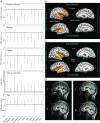Neurobiology of culturally common maternal responses to infant cry
- PMID: 29078366
- PMCID: PMC5692572
- DOI: 10.1073/pnas.1712022114
Neurobiology of culturally common maternal responses to infant cry
Abstract
This report coordinates assessments of five types of behavioral responses in new mothers to their own infants' cries with neurobiological responses in new mothers to their own infants' cries and in experienced mothers and inexperienced nonmothers to infant cries and other emotional and control sounds. We found that 684 new primipara mothers in 11 countries (Argentina, Belgium, Brazil, Cameroon, France, Kenya, Israel, Italy, Japan, South Korea, and the United States) preferentially responded to their infants' vocalizing distress by picking up and holding and by talking to their infants, as opposed to displaying affection, distracting, or nurturing. Complementary functional magnetic resonance imaging (fMRI) analyses of brain responses to their own infants' cries in 43 new primipara US mothers revealed enhanced activity in concordant brain territories linked to the intention to move and to speak, to process auditory stimulation, and to caregive [supplementary motor area (SMA), inferior frontal regions, superior temporal regions, midbrain, and striatum]. Further, fMRI brain responses to infant cries in 50 Chinese and Italian mothers replicated, extended, and, through parcellation, refined the results. Brains of inexperienced nonmothers activated differently. Culturally common responses to own infant cry coupled with corresponding fMRI findings to own infant and to generic infant cries identified specific, common, and automatic caregiving reactions in mothers to infant vocal expressions of distress and point to their putative neurobiological bases. Candidate behaviors embedded in the nervous systems of human caregivers lie at the intersection of evolutionary biology and developmental cultural psychology.
Keywords: culture; fMRI; infant cry; maternal responsiveness; neurobiology.
Conflict of interest statement
The authors declare no conflict of interest.
Figures





References
-
- Darwin CR. A biographical sketch of an infant. Mind. 1877;2:285–294.
-
- Lingle S, Wyman MT, Kotrba R, Teichroeb LJ, Romanow CA. What makes a cry a cry? A review of infant distress vocalizations. Curr Zool. 2012;58:698–726.
-
- Zeifman DM. An ethological analysis of human infant crying: Answering Tinbergen’s four questions. Dev Psychobiol. 2001;39:265–285. - PubMed
-
- Lester BM, La Gasse LL. Crying. In: Haith MM, Benson JB, editors. Encyclopedia of Infant and Early Childhood Development. Academic; San Diego: 2008. pp. 332–343.
Publication types
MeSH terms
Grants and funding
LinkOut - more resources
Full Text Sources
Other Literature Sources

